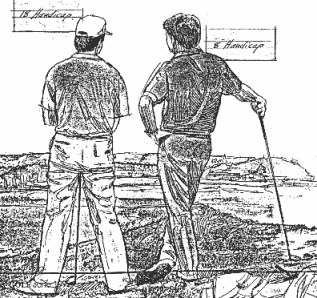|
Handicaps 103
The most dangerous opponents;
who has the edge;
where you get strokes,
The last of three parts
In parts one and two, we outlined the inner workings of handicaps. In this final part, we suggest ways to make them work for you.
Although handicaps are supposed to equalize matches, it's not always true, is it?
Unfortunately not. The scale is tipped in favor of the better player.
The way the formula works, for every six strokes difference in handicap, the better player has a one-stroke advantage, because the lower handicapper is more likely to play at or near his handicap than the high handicapper.
In a match between an eight handicapper and a 14 handicapper, the better player is giving away six strokes, yet the odds are still 60-40 that he will win the match.
Why?
As we explained in part one ("Handicaps 101," Apr., p. 97), the USGA set up its system to favor better players. Its philosophy is that handicaps should be based on potential rather than average ability.
Back to the math. In part one, when we told you how to figure your handicap, it was explained that after determining your differentials, using course rating and slope, the result is multiplied .096. To be truly equal, the result would have to be multiplied by .10'7. The lower number keeps the advantage with the better player.
How can I use handicaps to pick the best teammate in a four-ball match?
The advantage goes to the team with the biggest difference in handicaps. That means an eight and an 18 have a distinct advantage over two 13-handicappers, even though both combinations add up to 26. And the bigger the difference, the better the advantage. In fact, the USGA thinks that a team with a handicap difference greater than eight strokes has an unfair advantage.
Although the odds are stacked against a high handicapper head-to-head, a four-ball match is a bit different. As a partner, the high-handicapper is likely to come up with a few good holes to help his partner.

According to the odds, the eight and the 18 handicap players will win their match against two 13 handicappers.
Speaking of matches, what's the proper way to give strokes?
Do you give everyone full handicaps, or do you base it on the difference between players? Use the difference between players, then subtract the best player's handicap from everyone else's. An illustration shows why this method is equitable:
Fred is a seven handicap and George is an 18. George gets 11 strokes, the difference between their handicaps, and Fred doesn't get any. George's strokes are taken on the 11 lowest handicap holes designated on the scorecard.
Strokes are given this way because George needs the most help on the first 11 handicap holes. If both players took their full handicaps, George would have a stroke advantage on the last 11 handicap holes.
How are holes handicapped? Who does it?
Individual courses decide how to rank their holes. The common belief is that the numbers relate to the most difficult holes. That's not generally the case.
The idea is to rank holes in the order that strokes are necessary to get a halve with a better player.. That's why the longest hole, regardless of par, is usually the number one stroke hole: Average players can't overcome distance as well as better players.
The USGA suggests this sequence: difficult par fives, followed by difficult par fours, other par fives, other par fours, par threes. Only an exceptionally difficult par three would warrant being placed ahead of an exceptionally easy par four or par five.
The odd-numbered stroke holes are generally on the front nine and the even numbers on the back. The number one stroke hole should not be assigned to the first hole since that hole usually is used to decide play-offs. The number two stroke hole should never be the 18th, which prevents the match from ending before the higher handicapper gets to use his stroke.
All of this depends on the proper handicapping of golfers. Who polices them?
A club handicap committee should preside over such matters. If you don't have one, here are some guidelines:
At least four people should be on the committee, one of which is the pro. However, the pro should not be the chairman (a club employee shouldn't be put in the position of having final say over members).
The group should meet monthly, reviewing results of club tournaments, tee times, who posted scores, and � most importantly � who didn't post scores.
The committee's job is to see that every member posts scores .when he or she plays, and that those scores are not consistently out of line with that player's usual game.
� Mike Purkey
|




